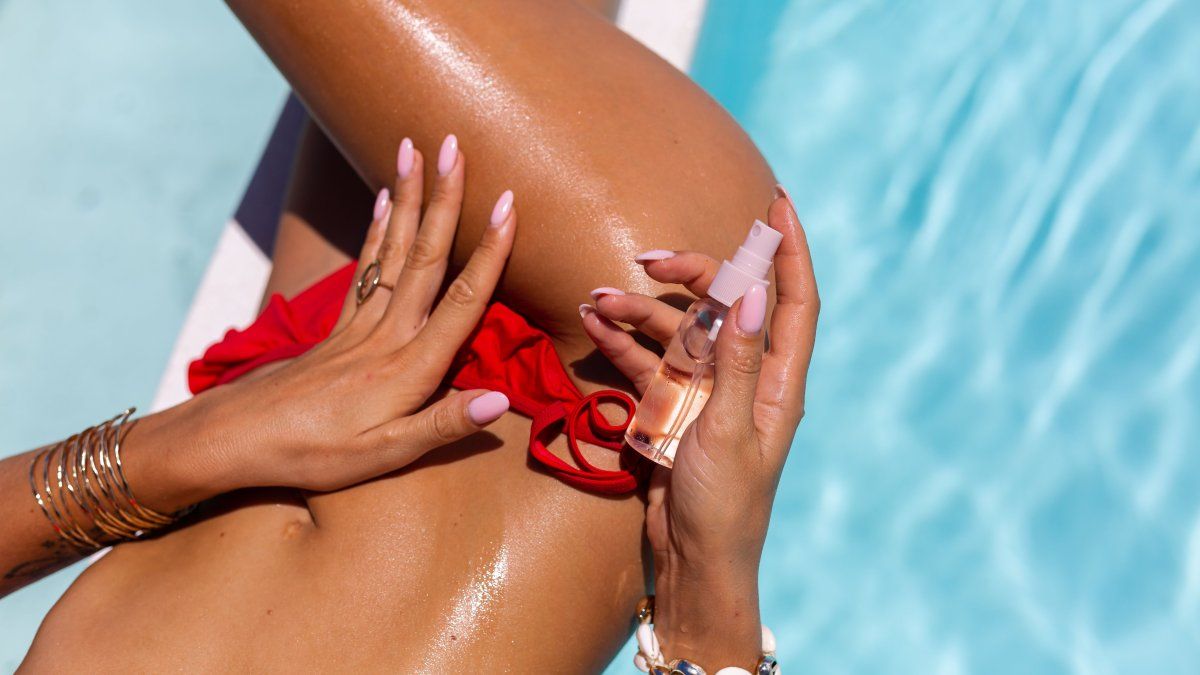He summer It brings with it warm days and many opportunities to enjoy the outdoors, but sun exposure can put the health of our skin at risk, which is why it is essential to take precautions and adopt care habits that protect us during this season.
The skin on your back may tan faster than other areas of the body due to several factors. Here I mention some possible reasons:
It is important to note that a deep tan can be a sign of sun damage. It is essential to protect your skin from the sun by using sunscreen with a high sun protection factor (SPF), seek shade, and avoid prolonged sun exposure.
Effects of the sun on the skin
“Sun exposure, through ultraviolet (UV) radiation, can cause serious damage to the skin. Some lesions appear immediately such as burns and blisters.
Others, such as premature skin aging, spots and even skin cancer, can occur over the years since the harmful effects of these radiation accumulate over time,” explains Dr. Valeria El Haj.
crop-woman-applying-suntan-lotion-leg.jpg
How to take care of your skin from the sun?
As for prevention measures, sunscreen is the most important and how to use it correctly as well. Therefore, when exposing yourself to the sun, you must keep in mind that you should apply it half an hour before exposing yourself to the sun, even on cloudy days, there must be a sufficient amount and it must be distributed evenly. In addition, sunscreen should be renewed every two to three hours, while outdoors and when leaving the pool or sea.
It is important to remember that sunscreen is not the only tool to protect ourselves from the sun, since factors such as the hours and duration of exposure, the choice of appropriate clothing and other measures also play a fundamental role:
- Avoid sun exposure during the hours of maximum irradiation (from 11 a.m. to 4 p.m. in the summer months).
- Carry out short and progressive exposures to the sun.
- Protect the skin with clothing, a hat and wear sunglasses.
- Do not use fragrances or cosmetics that may contain alcohol or substances that cause photosensitivity.
- Extreme sun protection against any outdoor activity. Do not forget that on cloudy days we must also take care of ultraviolet radiation and we must take all the measures mentioned.
Care of burns and scars in high temperatures
A scar, whether normal, hypertrophic or keloid, is the result of deep damage to the skin. Despite the skin’s incredible ability to regenerate, scars leave a visible mark on the surface.
Burns, for their part, are also deep, but are produced by highly intense aggressive agents such as direct fire, flammable or others of the same nature, or by prolonged contact with other agents. In these situations, the destruction of the skin is total and therefore there is no possibility of spontaneous recovery.
It is essential to take good care of burns or scars, especially during the summer when high temperatures can complicate recovery. Therefore, it is recommended:
- Avoid the sun: a healing scar is tremendously sensitive to UV radiation and its exposure can cause it to become pigmented and leave a much larger and visible lesion.
- Avoid the sea and the pool: chlorine, salt and humidity lengthen healing time and, therefore, increase the chances of healing irregularly.
- Sun protection: yes or yes, a scar exposed to the sun should always be protected with a broad-spectrum Spf50+ sunscreen and repeat the application frequently.
- Hydration and nutrition: a scar is skin healing, organizing and repairing itself at a rapid pace. Hydration and nutrition are essential to strengthen tissues and help them face these situations.
- Regarding diet, although there is no evidence that any food directly protects against sun damage, a healthy and varied diet helps keep the skin in good condition.
Skin care during cancer treatment
Taking care of your skin against the sun is especially important for people who have received chemotherapy, as the treatment can increase your skin’s sensitivity and propensity for damage. In addition, skin changes such as dryness, irritation and blemishes may occur.
These alterations are usually temporary and depend on the type of treatment. Therefore, it is recommended to protect the skin from the sun:
- – Apply broad spectrum (UVA and UVB) sunscreen with SPF 50+ every day, even if it is cloudy.
- – Choose gentle, hypoallergenic formulas designed for sensitive skin.
- – Reapply every two hours, especially when outdoors, sweating or after swimming.
- – Limit direct exposure to the sun, especially between 10 a.m. and 4 p.m.
- – Seek shade whenever possible and organize activities during times of lower solar radiation.
- – Wear long-sleeved clothing with built-in UV protection for greater care.
- – Complement with wide-brimmed hats that cover the face, neck and ears.
- – Protect your eyes with certified sunglasses with UV filters.
Moles and spots
Moles and spots can be harmless signs or early warnings of more serious conditions, such as melanoma. Therefore, keeping a photographic record of your skin scans is essential to detect changes in the number, shape or size of these marks over time. Screening and prevention not only protect your well-being, but can also save lives.
The ABCDE is a useful guide to know when it is necessary to go to a doctor:
- – Asymmetry: the two halves of the mole do not fit together.
- – Edge: irregular or uneven.
- – Color: spots with variations or changes (black, brown, red).
- – Diameter: greater than 6 mm.
- – Evolution: changes in appearance, size, bleeding or itching.
In the event of any warning sign, it is essential to consult a specialist to obtain an accurate and timely diagnosis.
“Finally, it is important to note that the skin has memory. Getting burned several times in the same area not only leaves visible traces, but also reinforces the need to take care of it with conscious actions, such as daily use of sunscreen and regular check-ups. Protecting your skin today is investing in your future health,” highlights Valeria el Haj.
Source: Ambito
I am an author and journalist who has worked in the entertainment industry for over a decade. I currently work as a news editor at a major news website, and my focus is on covering the latest trends in entertainment. I also write occasional pieces for other outlets, and have authored two books about the entertainment industry.




